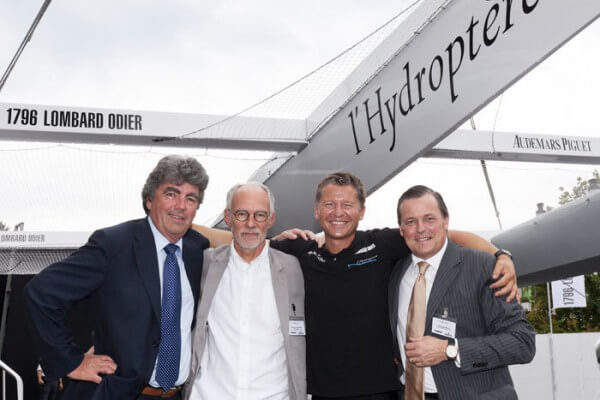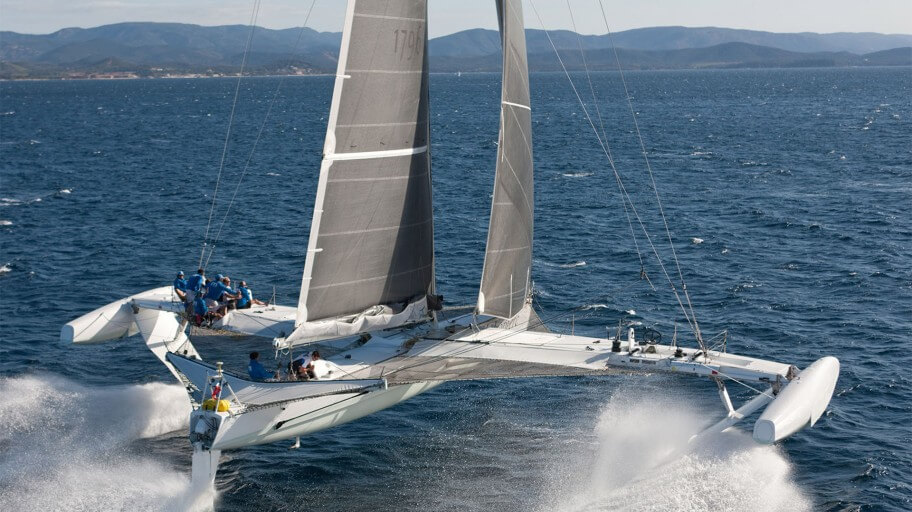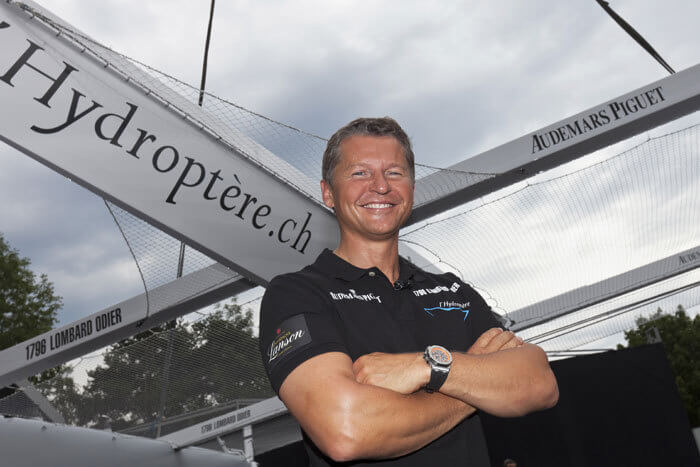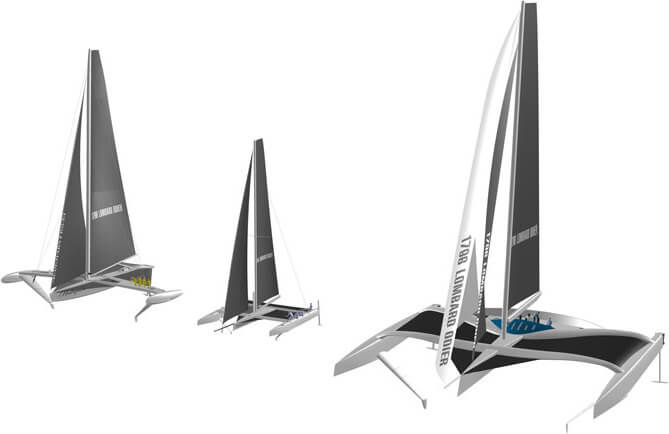Anyone who has had the chance to spend time messing about on boats will have no trouble understanding Alain Thébault’s infectious delight when at the helm of l’Hydroptère. This revolutionary catamaran, dubbed the “Formula 1 of the seas,” is the world’s fastest boat; the only one to have crossed the wind barrier, the 50-knot (92.6 km/h) threshold that is the nautical equivalent of breaking the sound barrier in aviation. Partners to this amazing project are, since 2005, Thierry Lombard, Managing Partner of the Geneva private bank Lombard Odier Darier Hentsch & Cie; the École Polytechnique Fédérale de Lausanne in its capacity as scientific consultant since 2006; and watchmaker Audemars Piguet which came onboard in 2009, weeks before the flying sailboat set its second sailing speed world record. On Sunday November 8th 2009, off the coast of Hyères in the south of France and in a 28-knot north-westerly wind, l’Hydroptère reached an average speed of 50.17 knots (93 km/h) over one nautical mile (1.85 km). This crowned a previous exploit, when on September 4th l’Hydroptère cut the waters at 51.36 knots (95 km/h) over 500 metres, with peaks at 55.5 knots (103 km/h). A new benchmark in the world of sailing.

Twenty-five years of perseverance
“Thanks to this historic double record, l’Hydroptère is confirmed as the fastest sailcraft on the planet. This exceptional performance is a tribute to the work of a determined and experienced team, which developed and implemented revolutionary and innovative solutions,” declared Philippe Merk, CEO of Audemars Piguet, the day after the second record. “We can fully relate to this extraordinary challenge, which is perfectly consistent with the pioneering and adventurous spirit of our brand.” A pioneering and adventurous spirit, but most importantly perseverance: three qualities without which l’Hydroptère could never have come about.
Eric Tabarly, the renowned distance sailor who was lost at sea in 1998, was first to imagine the concept of a “flying” boat, in 1976. His work didn’t go unheeded. In 1984, Alain Thébault showed Tabarly his own drawings, determined to transform the dream of lifting a multi-ton sailing boat out of the water into reality. This would be a time-consuming project, initially carried by eight engineers from Dassault Aviation and EADS-Airbus who volunteered their time. Their sailboat made its successful first “flight” in 1994. Sadly, the Delta tornado that swept the island of Lanzarote in 2005 put paid to this fabulous adventure. Until, that is, l’Hydroptère‘s new partners stepped in to resurrect the project.
The Hydroptere – the epic in 9 minutes!

A revolutionary hydrofoil trimaran
L’Hydroptère – from the Greek hydros, water, and ptera, wing – is a hydrofoil trimaran whose foils are actually underwater wings. Once a certain speed has been reached, these wings extract the hulls from the water, which considerably reduces the boat’s hydrodynamic drag. As l’Hydroptère‘s designers explain: “The hulls are raised by the vertical thrust produced by the foils. The foils are then the only parts in contact with the water, which considerably reduces drag and creates a far greater potential for speed than with classic Archimedean boats. The foils function according to the principle of dynamic lift, which is how the wings of a plane make the plane take off. The greater the speed of projection of the foil, the greater the lift. From a certain speed, the lift generated by the foils exceeds the weight of the boat and raises it out of the water. The geometry of the foils on l’Hydroptère has been calculated to limit the increase of this lift so that the boat stops rising and is stabilized a few metres above the surface of the water. This simple concept is easy to apply; however, the stress exerted is such that only the advent of high-tech materials such as carbon and titanium made it possible to make a large boat fly over the waves.”
This milestone has now been reached, with two world records to prove it. Not that the project’s team is stopping there. A second boat, l’Hydroptère.ch, is under construction and should soon take to the waters of Lake Geneva. This second craft is part of the technological and sporting programme of the crew led by Alain Thébault, whose ambition is to revolutionise the world of sailing and establish the concept of a flying boat. L’Hydroptère.ch is a new stage in this global endeavour, as the navigator confirms: “She is a laboratory and a think tank for the ambitious l’Hydroptère Maxi project, the ultimate goal of which is to sail round the world in 40 days, thus pursuing the dream of Jules Verne.” These three boats will set out to break the major records of pure speed, Atlantic crossing, Pacific crossing and circumnavigation.
The last word goes to Philippe Merk: “This ambitious new prototype reflects the pioneering spirit of Audemars Piguet, which since 1875 has extended the limits of its art through its quest for technological innovation, daring and excellence.”




















